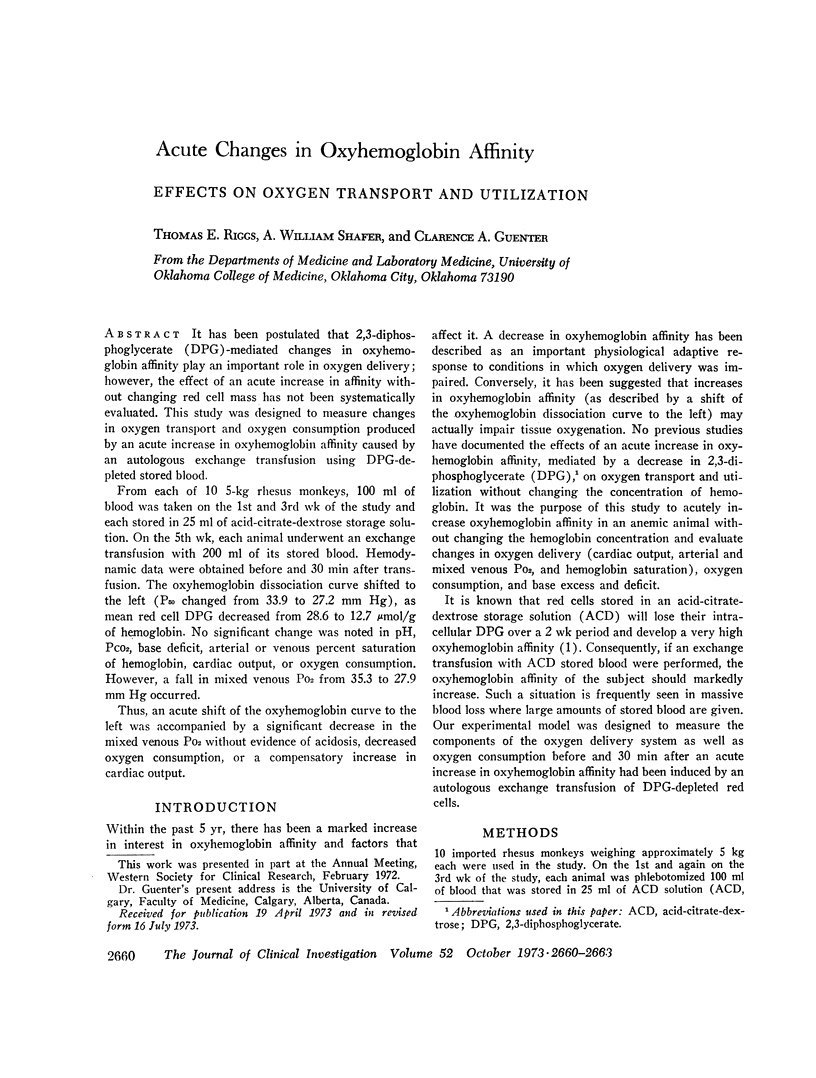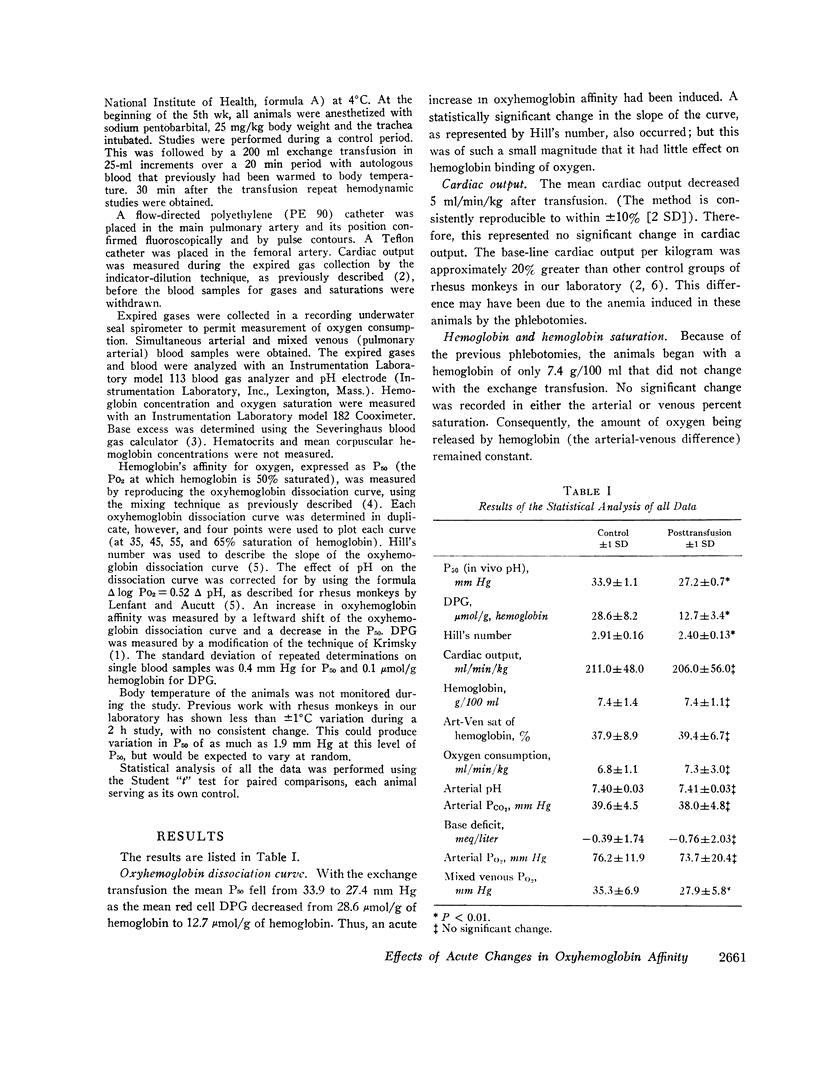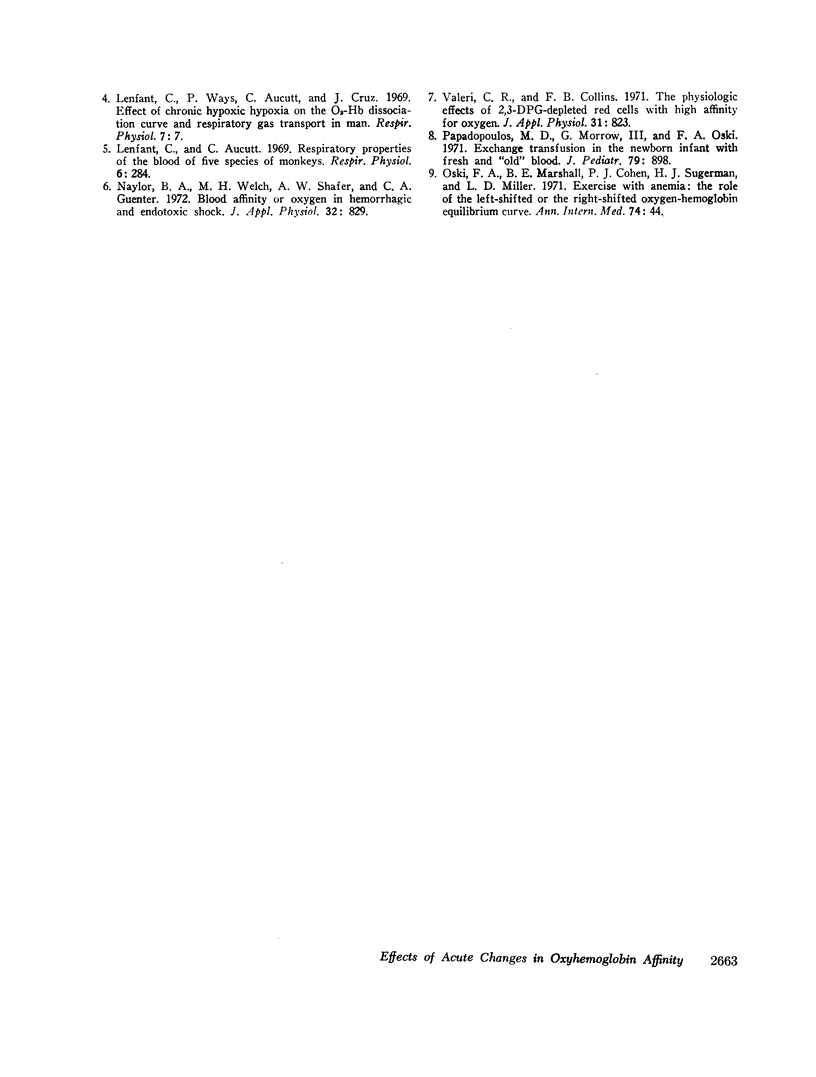Abstract
It has been postulated that 2,3-diphosphoglycerate (DPG)-mediated changes in oxyhemoglobin affinity play an important role in oxygen delivery; however, the effect of an acute increase in affinity without changing red cell mass has not been systematically evaluated. This study was designed to measure changes in oxygen transport and oxygen consumption produced by an acute increase in oxyhemoglobin affinity caused by an autologous exchange transfusion using DPG-depleted stored blood.
From each of 10 5-kg rhesus monkeys, 100 ml of blood was taken on the 1st and 3rd wk of the study and each stored in 25 ml of acid-citrate-dextrose storage solution. On the 5th wk, each animal underwent an exchange transfusion with 200 ml of its stored blood. Hemodynamic data were obtained before and 30 min after transfusion. The oxyhemoglobin dissociation curve shifted to the left (P50 changed from 33.9 to 27.2 mm Hg), as mean red cell DPG decreased from 28.6 to 12.7 μmol/g of hemoglobin. No significant change was noted in pH, PCO2, base deficit, arterial or venous percent saturation of hemoglobin, cardiac output, or oxygen consumption. However, a fall in mixed venous PO2 from 35.3 to 27.9 mm Hg occurred.
Thus, an acute shift of the oxyhemoglobin curve to the left was accompanied by a significant decrease in the mixed venous PO2 without evidence of acidosis, decreased oxygen consumption, or a compensatory increase in cardiac output.
Full text
PDF



Selected References
These references are in PubMed. This may not be the complete list of references from this article.
- Beutler E., Meul A., Wood L. A. Depletion and regeneration of 2,3-diphosphoglyceric acid in stored red blood cells. Transfusion. 1969 May-Jun;9(3):109–115. doi: 10.1111/j.1537-2995.1969.tb05527.x. [DOI] [PubMed] [Google Scholar]
- Delivoria-Papadopoulos M., Morrow G., 3rd, Oski F. A. Exchange transfusion in the newborn infant with fresh and "old" blood: the role of storage on 2,3-diphosphoglycerate, hemoglobin-oxygen affinity, and oxygen release. J Pediatr. 1971 Dec;79(6):898–903. doi: 10.1016/s0022-3476(71)80181-6. [DOI] [PubMed] [Google Scholar]
- Guenter C. A., Fiorica V., Hinshaw L. B. Cardiorespiratory and metabolic responses to liver E. coli and endotoxin in the monkey. J Appl Physiol. 1969 Jun;26(6):780–786. doi: 10.1152/jappl.1969.26.6.780. [DOI] [PubMed] [Google Scholar]
- Lenfant C., Aucutt C. Respiratory properties of the blood of five species of monkeys. Respir Physiol. 1969 Apr;6(3):284–291. doi: 10.1016/0034-5687(69)90027-9. [DOI] [PubMed] [Google Scholar]
- Lenfant C., Ways P., Aucutt C., Cruz J. Effect of chronic hypoxic hypoxia on the O2-Hb dissociation curve and respiratory gas transport in man. Respir Physiol. 1969 Jun;7(1):7–29. doi: 10.1016/0034-5687(69)90066-8. [DOI] [PubMed] [Google Scholar]
- Naylor B. A., Welch M. H., Shafer A. W., Guenter C. A. Blood affinity for oxygen in hemorrhagic and endotoxic shock. J Appl Physiol. 1972 Jun;32(6):829–833. doi: 10.1152/jappl.1972.32.6.829. [DOI] [PubMed] [Google Scholar]
- Oski F. A., Marshall B. E., Cohen P. J., Sugerman H. J., Miller L. D. The role of the left-shifted or right-shifted oxygen-hemoglobin equilibrium curve. Ann Intern Med. 1971 Jan;74(1):44–46. doi: 10.7326/0003-4819-74-1-44. [DOI] [PubMed] [Google Scholar]
- Severinghaus J. W. Blood gas calculator. J Appl Physiol. 1966 May;21(3):1108–1116. doi: 10.1152/jappl.1966.21.3.1108. [DOI] [PubMed] [Google Scholar]
- Valeri C. R., Collins F. B. Physiologic effects of 2,3-DPG-depleted red cells with high affinity for oxygen. J Appl Physiol. 1971 Dec;31(6):823–827. doi: 10.1152/jappl.1971.31.6.823. [DOI] [PubMed] [Google Scholar]


